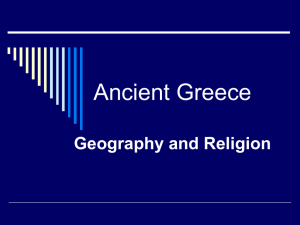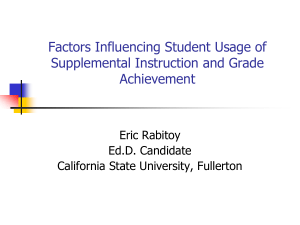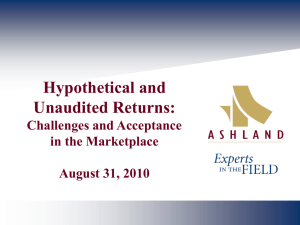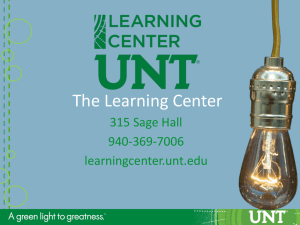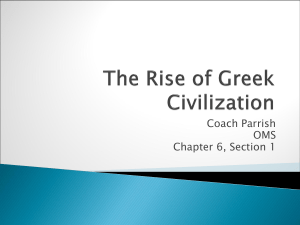PPT
advertisement
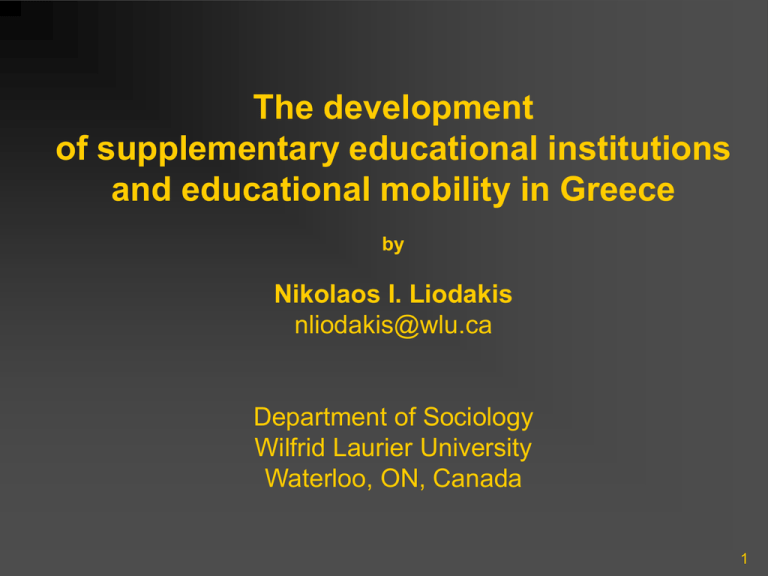
The development of supplementary educational institutions and educational mobility in Greece by Nikolaos I. Liodakis nliodakis@wlu.ca Department of Sociology Wilfrid Laurier University Waterloo, ON, Canada 1 This presentation will provide: A terminology useful for examining Supplemental Education (SE) in Greece An analysis of the types of SE Information on the size and cost of SE Explanations for the development, entrenchment and expansion of SE A discussion of SE effects on student educational mobility which is based upon: their parents’ socio-economic status their parents’ educational level students’ place of residence and gender. 2 Useful Terminology Παραπαιδεία (para-pedia) = para – education, or “shadow” educational system Φροντιστήριο (frontistirio) = the physical space/building where private (for profit) supplemental education takes place Φροντιστήριο (frontistirio) = the process of delivering private supplemental education Supplemental Education (SE) in Greece = Frontistiri-a (plural) + Private lessons - Ιδιαίτερα (idietera) 3 Types of private supplemental education More than 3,500 organized frontistiria country-wide, depending on subject and level of education On foreign languages (mostly English, French, German, Italian, Russian, Spanish, etc). On regular school subjects other than foreign languages (mostly mathematics, physics, chemistry, modern and ancient Greek language, biology, economics, etc.), for two interrelated reasons: To improve school grades To do well in university entrance exams For 3 educational levels: elementary (grades 1-6), junior high school (gymnasium, grades 7-9), and high school (lyceum, grades 10-12). Important distinction: private schools not considered frontistiria 4 Size and cost of supplemental education The size of the supplemental education sector in Greece is huge, in terms of: The number of teachers it employs It is estimated that 50% of all employed teachers are employed in supplemental education institutions The % of students who attend e.g., At the high school (Lyceum) level: Frontistiria 1984 54,6% 1993 65% Private Lessons 09,4% 30% Total 64% 95% Today: almost all Grade 12 high school students attend SE 5 Size and cost of supplemental education SE in Greece is a huge (profitable) industry. Recent reliable data (2007) on educational expenditures: National (state) expenditures, in €: 7,034,294,592 All private household expenditures: 4,924,411,934 European Union annual contributions: 1,510,045,263 Supplemental education costs for households are estimated at €1,7 billion per annum. It is 35% of all private household educational expenditures. 6 Size and cost of supplemental education State educational expenditures as % of GNP 2005: 3.19% 2007: 3.07% Expenditures on supplemental education as % of family income 1994-1999: 4.79% 2000-2005: 5.19% Family expenditures by type and level of supplemental education: 7 8 Why frontistiria in Greece? Causes for the emergence and continued expansion of SE in Greece include: The nature of the Greek educational system, in terms of its structure and orientation (entrance exams), (dys-) functions and outcomes (“results”) The role of the state as educational provider and employer The prevalent ideology on the socio-economic role of education (cultural obsession) The nature and (perceived) effectiveness of SE in accessing post-secondary education and in knowledge acquisition The actual relationship between educational attainment, employment, income and social status 9 The Greek Educational System The nature of the Greek educational system is very competitive, especially at the high school level (Lyceum) Also: highly “unstable”, i.e., educational reforms are frequent (one Minister per annum), but not necessarily successful System is exam-centred, not knowledge-centred. Main problem is the country-wide, annual university entrance exams Fewer positions than applicants Unbalanced, irrational distribution of available university positions in terms of student demand (not of the market) for certain fields of study and supply of available positions in those fields. This leads to increased competition among students. 10 Regional Educational Imbalances Regional distribution of positions and quality of Universities: Available university and college positions in high demand fields (medicine, law school, teachers’ college, computers, business) are fewer than the student demand (not necessarily fewer than the market demand) These are found in urban, prestigious Universities (Athens, Salonika, Crete, Patras, etc.) Greater numbers of university and college positions are available in regional universities and colleges (Aegean, Thessaly, Ionian Islands, Epirus, etc.), but in fields that are not in high demand, so students do not want to go there. E.g., floriculture and landscaping, textile studies, aquaculture, livestock studies, early childhood education, folk music, etc. 11 The Greek State, Education and Employment Since 1960s, role of the state as provider of employment has increased, expected given the size of the private sector Today, state has to deal with immense socio-political and economic pressures to provide employment for qualified university graduates (considered a right of graduates) Size of SE creates employment opportunities for graduates, eases demands on state employment (working conditions a different issue) State policy on SE contradictory: rhetoric of dismantling parapedia, policies that encourage it and increase its necessity and size, e.g., difficult entrance exams, more subjects, intensification of educational process, competition. 12 Ideology on Education: a cultural obsession? Clear class and political character of education prior to 1964 reforms (free education, accessible to all) Historically, post-secondary education associated with higher social status, prestige, employment in the public sector, higher income, etc. Competition for access to post-secondary education great, so a scarce and valuable resource Nature of Greek economy, regional disparities, agricultural and urban economies The Greek (lower and middle class) dream or better, obsession: “I want my kids to go to University and become doctors, lawyers, teachers” 13 The Nature and Effectiveness of SE SE is well-organized as a system, more functional than the state (public) system More flexible and more adaptive than the formal state system (e.g., class size, adoption of non-text based materials, use of computers, internet, other technologies, study of interesting subjects, etc.) More effective in improving grades and in preparing students for university entrance exams (84.7% SE yes, 2.5% public yes) 14 The Nature and Effectiveness of SE More effective in advising students about immediate university field choices and future employment opportunities (called “vocational orientation”) SE has become more important in educational mobility than the public system Not all SE institutions are effective. Usually, the higher the fees the better the quality of SE provided SES of parents is important for students’ accessing better SE institutions, and therefore accessing university positions Geography is also important. There is a clear gap between rural areas and urban centres in both access to and quality of SE institutions 15 The Nature and Effectiveness of SE Parents’ education is also important. The higher their education the higher their kids’ educational success Gender of students does not matter in university access, but it does matter in field of study choices SE part of larger society and economy Not egalitarian Reproduces initial SES inequalities Tends to increase the gap between urban/rural students that is usually also an income and social class gap Post-secondary education is more likely to lead to employment, higher income, prestige, etc. 16 The Future of SE Evidence of decrease of intensification of entrance exams New government proposes 4 instead of 6 exam subjects, less material to cover Also proposes to increase value of secondary diploma, disassociate secondary education and entrance exams, give more authority to Universities to decide entrance process Economic burden on families increasing, given the current situation; political pressures on government increasing, but Unless some drastic and effective socio-political action takes place, no immediate or substantial changes are foreseen 17


